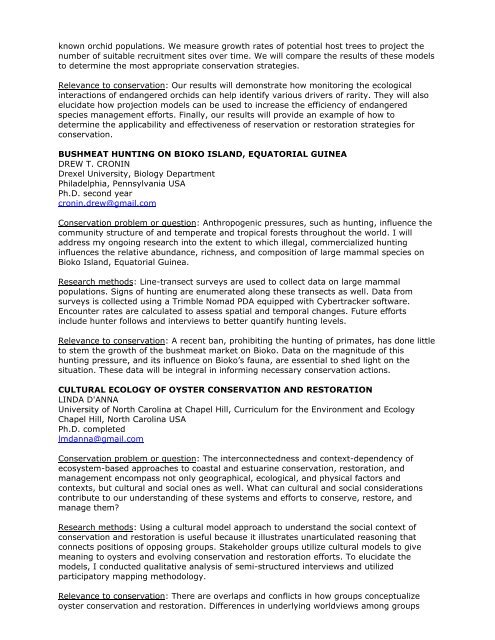Poster Abstracts in Word 29oct - American Museum of Natural History
Poster Abstracts in Word 29oct - American Museum of Natural History
Poster Abstracts in Word 29oct - American Museum of Natural History
You also want an ePaper? Increase the reach of your titles
YUMPU automatically turns print PDFs into web optimized ePapers that Google loves.
known orchid populations. We measure growth rates <strong>of</strong> potential host trees to project thenumber <strong>of</strong> suitable recruitment sites over time. We will compare the results <strong>of</strong> these modelsto determ<strong>in</strong>e the most appropriate conservation strategies.Relevance to conservation: Our results will demonstrate how monitor<strong>in</strong>g the ecological<strong>in</strong>teractions <strong>of</strong> endangered orchids can help identify various drivers <strong>of</strong> rarity. They will alsoelucidate how projection models can be used to <strong>in</strong>crease the efficiency <strong>of</strong> endangeredspecies management efforts. F<strong>in</strong>ally, our results will provide an example <strong>of</strong> how todeterm<strong>in</strong>e the applicability and effectiveness <strong>of</strong> reservation or restoration strategies forconservation.BUSHMEAT HUNTING ON BIOKO ISLAND, EQUATORIAL GUINEADREW T. CRONINDrexel University, Biology DepartmentPhiladelphia, Pennsylvania USAPh.D. second yearcron<strong>in</strong>.drew@gmail.comConservation problem or question: Anthropogenic pressures, such as hunt<strong>in</strong>g, <strong>in</strong>fluence thecommunity structure <strong>of</strong> and temperate and tropical forests throughout the world. I willaddress my ongo<strong>in</strong>g research <strong>in</strong>to the extent to which illegal, commercialized hunt<strong>in</strong>g<strong>in</strong>fluences the relative abundance, richness, and composition <strong>of</strong> large mammal species onBioko Island, Equatorial Gu<strong>in</strong>ea.Research methods: L<strong>in</strong>e-transect surveys are used to collect data on large mammalpopulations. Signs <strong>of</strong> hunt<strong>in</strong>g are enumerated along these transects as well. Data fromsurveys is collected us<strong>in</strong>g a Trimble Nomad PDA equipped with Cybertracker s<strong>of</strong>tware.Encounter rates are calculated to assess spatial and temporal changes. Future efforts<strong>in</strong>clude hunter follows and <strong>in</strong>terviews to better quantify hunt<strong>in</strong>g levels.Relevance to conservation: A recent ban, prohibit<strong>in</strong>g the hunt<strong>in</strong>g <strong>of</strong> primates, has done littleto stem the growth <strong>of</strong> the bushmeat market on Bioko. Data on the magnitude <strong>of</strong> thishunt<strong>in</strong>g pressure, and its <strong>in</strong>fluence on Bioko’s fauna, are essential to shed light on thesituation. These data will be <strong>in</strong>tegral <strong>in</strong> <strong>in</strong>form<strong>in</strong>g necessary conservation actions.CULTURAL ECOLOGY OF OYSTER CONSERVATION AND RESTORATIONLINDA D'ANNAUniversity <strong>of</strong> North Carol<strong>in</strong>a at Chapel Hill, Curriculum for the Environment and EcologyChapel Hill, North Carol<strong>in</strong>a USAPh.D. completedlmdanna@gmail.comConservation problem or question: The <strong>in</strong>terconnectedness and context-dependency <strong>of</strong>ecosystem-based approaches to coastal and estuar<strong>in</strong>e conservation, restoration, andmanagement encompass not only geographical, ecological, and physical factors andcontexts, but cultural and social ones as well. What can cultural and social considerationscontribute to our understand<strong>in</strong>g <strong>of</strong> these systems and efforts to conserve, restore, andmanage them?Research methods: Us<strong>in</strong>g a cultural model approach to understand the social context <strong>of</strong>conservation and restoration is useful because it illustrates unarticulated reason<strong>in</strong>g thatconnects positions <strong>of</strong> oppos<strong>in</strong>g groups. Stakeholder groups utilize cultural models to givemean<strong>in</strong>g to oysters and evolv<strong>in</strong>g conservation and restoration efforts. To elucidate themodels, I conducted qualitative analysis <strong>of</strong> semi-structured <strong>in</strong>terviews and utilizedparticipatory mapp<strong>in</strong>g methodology.Relevance to conservation: There are overlaps and conflicts <strong>in</strong> how groups conceptualizeoyster conservation and restoration. Differences <strong>in</strong> underly<strong>in</strong>g worldviews among groups
















